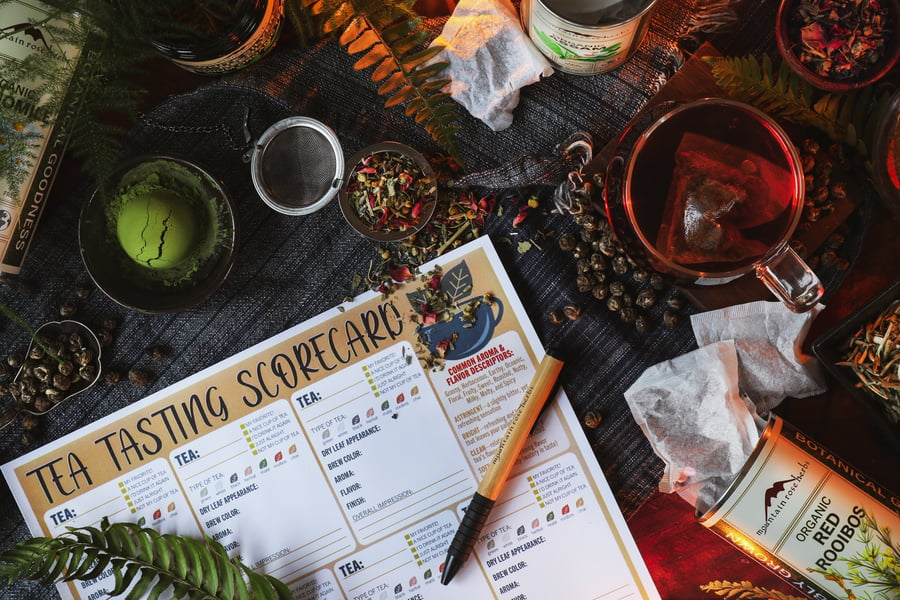In the worlds of fine wine or artisanal cheese, you’re likely to encounter terminology that can seem foreign to those who are not waist-deep in the art of vinification or caseiculture. Tea-tasting is similar in that tea connoisseurs use a unique language to describe the subtle nuances that you can find in a quality cup of tea. Fear not tea-enthusiast friends—I'm here to help you decode the descriptive terminology used in professional tea-tasting!
Prior to diving into the deep sea of tea terminology, the extent of my tea-vocabulary came to a screeching halt beyond “this green tea tastes a bit grassy” or “chamomile reminds me of my grandma’s vanilla cookie recipe”. Swimming through the countless notes of flavor and fragrance waiting to be uncovered in a mug of tea can admittedly be a bit daunting. With that in mind, I’ve broken the terms down to a glossary of 20 commonly encountered tea descriptors to make tea knowledge a bit easier to sip, so you don’t have to take a piping-hot gulp of all the complex terminology at once.
Guide to Tea-Tasting Terminology
- Aroma: Also referred to as the “nose”, aroma is the scent a tea carries from your cup to your nostrils.
- Acidic: The mouth-puckering flavor reminiscent of biting into an underripe green apple.
- Astringent: The slightly bitter, yet refreshing sensation created by the reaction between the tannins (polyphenols) within tea and the proteins in our saliva.
- Body: Encompasses the tea’s weight and substance in the mouth. Commonly classified as light-, medium-, or full-bodied.
- Bright: The refreshing and bubbly flavor that leaves your pallet feeling cleansed and ready for another sip!
- Bakey: An undesirable quality to describe tea that was subjected to too-high temperatures during the processing stage.
- Character: A tea’s signature traits, typically correlating with its country or region of origin.
- Clean: Relating to the purity of a tea’s flavor, absent of unexpected flavors or aromas.
- Coppery: Relating to tea color, ideally being a warm shade of copper.
- Finish: The lingering mouthfeel after taking a sip of tea.
- Flowery: Floral notes in either the scent or flavor of tea. Commonly used to describe herbal teas.
- Liquor: The liquid and hue that are consistent in properly brewed tea. Liquor is the #1 parameter expert tea tasters use when determining the qualities of a tea.
- Malty: The sweet and uniquely malty flavor typically used to describe Assam black tea.
- Muscatel: This flavor’s origin stems from muscat grapes. Commonly used when referring to quality Darjeeling teas.
- Smooth: A round-bodied flavor that checks all the boxes from the tip of your tongue to the back of your throat.
- Smoky: A toasty flavor reminiscent of campfire smoke or a warming sip of mezcal.
- Soft: An underwhelming flavor lacking complexity. In simpler terms, slightly watery in taste.
- Thick: Referring to a tea with a good amount of “substance”, not relating to the liquor’s viscosity.
- Vegetal: Commonly used to describe green teas that are grassy, herbaceous, or even marine in flavor.
- Woody: A “forest” or “timber” aroma or body typically found in teas harvested later in the season.
Remember, there's no right or wrong way to enjoy tea—it's all about slowing down and taking the time to be mindful of the subtle characteristics that each tea imparts. Next time you find yourself pouring a freshly brewed cup, take a moment to savor the notes that cross each of your senses. As you take a slow sip with intention, how does your new tea terminology help you articulate your experience?
You may also be interested in:
- Explore Mountain Rose Herbs' Tea Sampler Sets
- Guide to Brewing Tea
- Guide to Black Tea
- Guide to Green Tea













